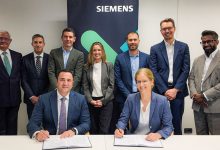New Supercomputing System HPC5
World’s Most Powerful for Industrial Use

Eni, the Italian energy group, announced the supercomputer named HPC5, a GPU-accelerated system capable of performing 52 million billion operations per second, is now in use.
HPC5 will help Eni accelerate research and development of clean energy sources, as well as supporting exploration and the monitoring of oil fields.
Equipped with 1820 Dell EMC servers, each with four NVIDIA V100 Tensor Core GPUs, interconnected via Mellanox’s InfiniBand, the system is designed for the most efficient server and data storage connection.
In total, the system is comprised of 7,280 NVIDIA V100 GPUs.
The supercomputer is the first of its kind in the oil and gas industry, and when compared to the current Top 500 supercomputers list, would rank as the fifth most powerful in the world.
“This system is able to boost and even further refine the highly complex processes that support Eni’s people in their activities and therefore accelerate our digital transformation,” said Claudio Descalzi, CEO, Eni. “This is an important time in the path toward the energy transition. It’s another step forward to the global goal that we share with our research and technology partners: making tomorrow’s energy an even closer reality,” added Claudio Descalzi.
Technology
HPC5 is a set of parallel computing units with a peak processing power of 51.7 petaFlops. Combined with the supercomputing system in operation since 2018 (HPC4), the peak computational capacity of the infrastructure totals 70 petaFlops: that is, 70 million billion mathematical operations performed in a single second. Its full name is High Performance Computing – layer 5. It is Eni’s latest-generation supercomputer – one of the ten most powerful in the world and the most powerful outside government ownership. But it is also one of the ‘greenest’ on the planet – or in other words, with the lowest electricity consumption per petaFlop.
“If we disregard experimental supercomputers and consider only true supercomputing systems, HPC4 is the leading computer in the world in terms of energy savings. A single watt of electricity enables it to perform almost twenty billion operations per second. The performance level of this computer means it can use extremely sophisticated in-house algorithms to process subsoil data. The geophysical and seismic information we collect from all over the world is sent to HPC5 for processing. Using this data, the system develops extremely in-depth subsoil models, and on the basis of these, we can determine what is hidden many kilometres below the surface: indeed, this is how we found Zohr, the largest gas field ever discovered in the Mediterranean,” Eni’s representatives affirmed.
While the production of gas and oil continues in the energy industry’s traditional geographic areas, the next frontier of exploration is shifting towards increasingly remote places, and going deeper and deeper underground. And all this is occurring while the demand for global energy calls for rapid response times. In this environment, identifying new resources and bringing them into production as fast as possible becomes a serious challenge. The use of a supercomputer like HPC5 enables Eni to increase the accuracy of its studies of underground rocks, reducing the margin for error in prospecting operations and decreasing time-to-market, or the time between the identification of the field and the launch of production. This also has a positive impact on sustainability, as it reduces waste, both in terms of energy and resources.
Technological challenge
HPC5 is a computing cluster, or in other words, a set of computers that work together to multiply overall performance. The power of this supercomputer is three times that of its predecessor, HPC4. To keep energy consumption to a minimum, a hybrid architecture has been selected to optimise performance: as such, HPC5 and HPC4 use GPU computation (graphic processing units – GPUs – optimised for calculating large volumes of data in parallel), and these are very energy efficient. Indeed, with just one watt of power, a GPU can carry out over 10,000 million billion mathematical operations. In addition, every single computer has two CPU sockets; HPC4 also has two sockets for graphics accelerators, while HPC5 has four sockets. In total, the machine has access to more than 3400 computing processors and 10,000 graphics cards. This type of hardware, coupled with Eni’s proprietary algorithms, enables them to produce three-dimensional models of the subsoil that lie at a depth of 10-15 km, with a surface area of hundreds of km2 and a resolution of a few dozen metres. Once the hydrocarbons have been found, Eni’s geologists again use supercomputers to model the deposits and optimise their exploitation. Equally important was the contribution to the launch of the new EST reactor, which converts heavy refining residues into high quality light products. Moreover, from a strategic point of view, the memory of this computing behemoth stores the data of all the explorations and all the fields discovered by Eni in over sixty years of history, and this provides the basis for the development of the best methods for extracting the hydrocarbons that these areas still contain.
Energies of tomorrow
But HPC5 and HPC4 are not just used to discover new deposits, to model existing discoveries or to improve refining, but will also be used more and more for the energies of tomorrow The two supercomputers run original programs for research into magnetic confinement fusion: development of superconducting magnets in the joint Eni-CNR research centre in Gela and the study of plasmas in the research centre in San Donato Milanese. This is where the theoretical modelling takes place of the photoactive molecules and polymers that are at the core of new technologies for capturing solar: OPV organic solar panels and LSC luminescent solar concentrators. Lastly, Eni supercomputers are used to build advanced mathematical models combining meteorological and marine information with information on the behaviour of Marenergy technologies, such as ISWEC or Power Buoy, which generate electricity from wave motion. Meanwhile, detailed weather and climate models of the Arctic on a continental scale are developed at the joint Eni-CNR research centre in Lecce – with the essential support, of course, of the computing power of their supercomputers. Finally, the supercomputer will be fundamental in the development of Eni’s artificial intelligence projects, a new line of research that they are working on with IBM.
Environmental impact
HPC5 helps Eni to progressively improve its environmental performance, because increasing the efficiency of what they do allows them to reduce waste: in terms of energy, resources and time. In additions, 10-15% of the power provided to HPC4 is delivered by a photovoltaic system with 1MW of power, consisting of 2968 solar tracker photovoltaic modules distributed over 106 strings, part of their Progetto Italia initiative. Moreover, courtesy of its special environmentally-friendly design, the Green Data Center that houses the supercomputer enables Eni to save around 4500 tons of CO2 per year compared to a normal data centre. Today, for 90% of the year, the machines are cooled via the low-speed circulation of air, thanks to a system of pipes that intercepts air from the surrounding environment and filters it, before returning it cleaner than before. Accordingly, the use of air conditioning is minimal.
Project highlights: HPC5 – data, performance and results
- 51,7 million billion mathematical operations performed in a second
- 1820 total computers
- 7280 total GPU cards






